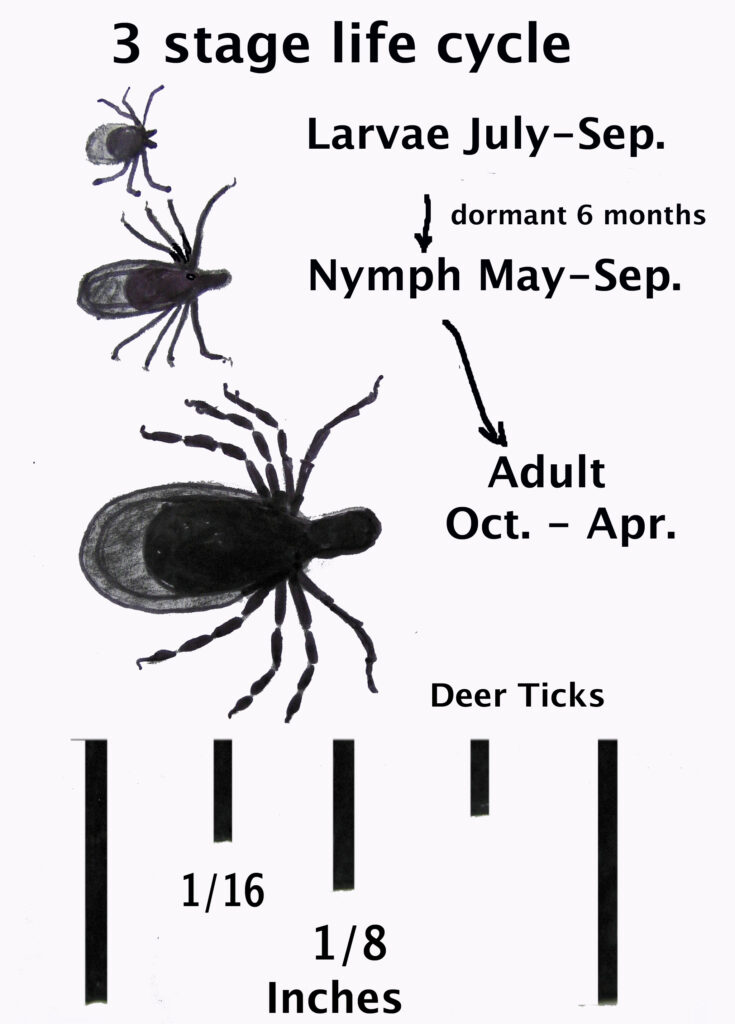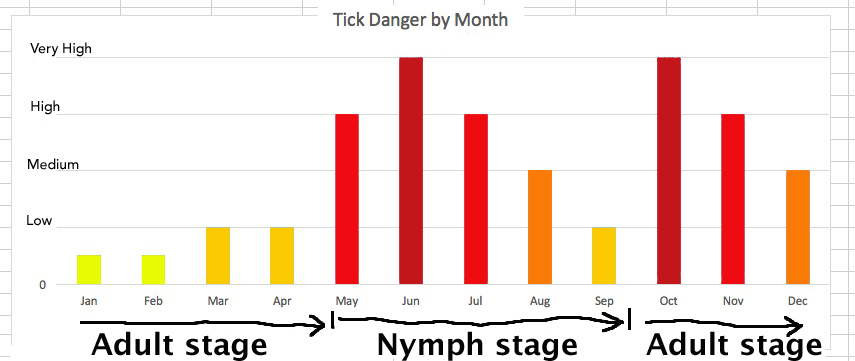A Warning About Ticks
Ticks are very prevalent in our region and, since they can transmit serious diseases, they are one of the biggest potential health threats one may encounter while enjoying the outdoors. Not only do some ticks carry Lyme disease, but also Rocky Mountain spotted fever, anaplasmosis, babesiosis, and other diseases. Furthermore, it is suspected that the bite of a Lone Star Tick can trigger an allergy to red meat.
Often ticks are described as being about the size of a period at the end of a sentence. That’s true sometimes but not always.
As ticks progress through a 3-stage life cycle they grow substantially larger. So, depending on the time of year, you will encounter different size ticks. Also, tick activity changes over time. So the risk level varies throughout the year. In order to help recognize ticks, it’s useful to know about their life cycle. Figure 1 shows the life cycle for the black-legged tick, also called the deer tick.

Stage-1: In May each adult female will lay several thousand eggs. Tiny larvae hatch in July. They’re only 1/32 inch long.
Larvae immediately begin searching for their first host, often bitting either a mouse or bird. Bacteria can be picked up during this first blood meal.
During each stage ticks only bite once. Therefore larvae don’t transmit infection. So they are not a major concern.
In September larvae go dormant until May of the following year.
Stage-2: In May the larvae from the previous year transform into nymphs that are 1/16 inch long.
May is one of the peak times to be bitten by a tick. That’s because the hungry nymphs are actively searching for an animal to bite.
As summer progresses more nymphs have found a host already and the tick danger drops.
Finally, in September, ticks become uncommon as they are busy transforming.

Stage-3: In October large adult ticks emerge. They’re 1/8 inch long. The hungry adults begin searching for a meal.
October is another peak month for tick bites. Adult ticks are more likely to carry infection. They are active between October and May of the following year.
Ticks can be active in winter if the temperature is above 40F.
Figure 2 shows the relative tick danger level over the course of a year.
*** The best way to avoid getting sick is to avoid being bitten. ***
Permethrin, an insecticide, is an excellent defense against ticks. It must be applied to clothing hours in advance, so plan accordingly.
Light colored clothing gives you an advantage to see a tick on you. There are several alternatives to Permethrin such as DEET, Picaridin and Oil of eucalyptus.
*** It’s always a good idea to perform a tick check upon returning home. ***
One sneaky habit of ticks is to ride home on your clothing. Dry heat from a clothes dryer can kill them.
Ticks like water, even soapy water. Scientists found that 80% of ticks survived a trip through a washing machine!
If you do find a tick here’s how to deal with it. First, if it’s not embedded in your skin, adhesive tape is a handy way to capture it and seal it up.
If it is embedded then use small tweezers, grip the tick as close to the skin as possible and pull until it comes out.
Avoid squeezing the body because that forces fluids out which may be infectious.
It is believed that if the tick is removed within 24 hours the chances of bacterial infection are small.
Until recently bacterial infection was all we had to worry about. But, in 2010 ticks were found to carry the Powassan virus.
The virus can be transmitted almost instantly. And it can cause dangerous encephalitis.
So far there are no reported cases of this virus in Maryland.
—— Additional information ——
* You usually don’t feel a tick bite because ticks inject an anesthetic that numbs the area. They also inject an anti-coagulant and an immunosuppressant.
* Mature ticks have 8 legs, like a spider. And, in fact, ticks are related to spiders. However larvae only have 6 legs.
—— Useful links ——-
Tick-borne illness
Lyme Disease
Red Meat Allergy
Permethrin facts
http://npic.orst.edu/factsheets/PermGen.html
Tick repellants
